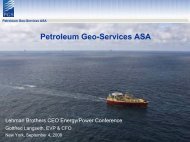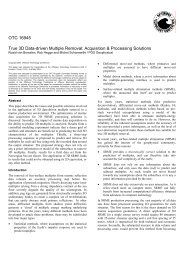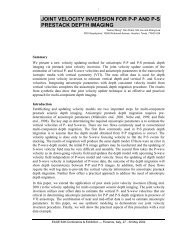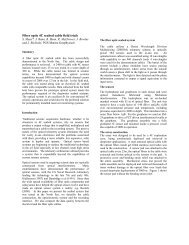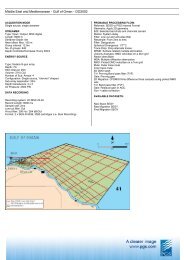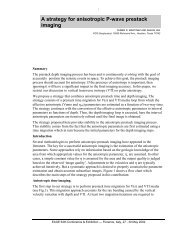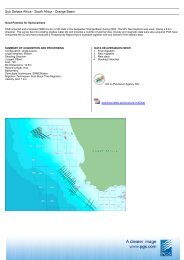Annual Report 2011 - PGS
Annual Report 2011 - PGS
Annual Report 2011 - PGS
You also want an ePaper? Increase the reach of your titles
YUMPU automatically turns print PDFs into web optimized ePapers that Google loves.
Marine Contract<br />
OptoSeis:<br />
Enhancing Reservoir<br />
Production<br />
In appropriate cases, the geophysical and<br />
logistics aspects of a producing reservoir warrant<br />
the use of seismic receivers permanently<br />
installed on the seabed. <strong>PGS</strong> has developed<br />
the OptoSeis fiber-optic system to meet this<br />
emerging market. The system offers a number of<br />
basic benefits: no in-sea electronics, lightweight,<br />
safe and robust operations over at least two<br />
decades without intervention, deepwater<br />
deployment, adaptable multi-component<br />
configuration and life-of-field cost-effectiveness.<br />
Imaging improvements are also significant:<br />
OptoSeis features a high dynamic range, low<br />
noise and crosstalk and high channel count.<br />
Operational benefits include on-demand periodic<br />
and continuous (passive) 4D acquisition, low<br />
operating costs, superior repeatability and more<br />
frequent updating of the reservoir model. Going<br />
forward, reservoir experts may consider OptoSeis<br />
the ultimate reservoir management solution.<br />
In today’s market there are three potential<br />
providers of permanently installed fiber-optic<br />
monitoring solutions: <strong>PGS</strong>, TGS and CGGVeritas.<br />
TGS entered the market after acquiring Stingray<br />
in <strong>2011</strong> and CGGVeritas established a market<br />
presence following the merger with Wavefield<br />
Inseis and its subsidiary Optoplan.<br />
Activity in the market for permanent monitoring<br />
systems has been fairly low. In 2008, CGGVeritas<br />
was awarded a contract to supply a seabed<br />
seismic sensor system for reservoir monitoring<br />
at the ConocoPhillips’ operated Ekofisk field<br />
in the North Sea. In 2010, <strong>PGS</strong> was awarded a<br />
contract by Petrobras to install a permanent<br />
seismic monitoring system at the Jubarte Field<br />
in the North Campos basin, Espiritos Santo<br />
province, offshore Brazil. Installation of the<br />
system is scheduled to be completed in 2012.<br />
This project is a significant step forward in the<br />
use of geophysics for reservoir surveillance,<br />
especially the application of 4D4C seismic to<br />
map the flow of fluids in Brazil’s deepwater<br />
reservoirs. OptoSeis data will improve the<br />
quality and timeliness of information that<br />
Petrobras geophysicists analyze and forward to<br />
their colleagues, the reservoir and production<br />
engineers who operate the offshore fields.<br />
Tendering activity for permanent monitoring<br />
solutions has increased and there is considerable<br />
potential for OptoSeis permanent monitoring<br />
solutions to become an important <strong>PGS</strong> business<br />
niche.<br />
What is Reservoir Monitoring?<br />
Conducting repeat seismic surveys generates<br />
information vital to optimizing reservoir<br />
production and maximizing resource recovery.<br />
Production and management techniques apply<br />
cell-based model simulations of reservoir<br />
production. History matching is used to reconcile<br />
predicted with actual reservoir state and behavior<br />
observations; the results facilitate modification<br />
of the current reservoir model. New 3D seismic<br />
data is periodically acquired across the reservoir<br />
to further update the reservoir model, particularly<br />
when history matching proves inadequate.<br />
Successive 3D seismic surveys over a field are<br />
referred to as time-lapse 3D or a 4D survey.<br />
Classic applications for 4D seismic include the<br />
identification of bypassed reserves, placement<br />
of injection wells, identification of unknown<br />
permeability conduits, depletion monitoring and<br />
CO2 sequestration.<br />
<strong>PGS</strong> has dedicated staff with expertise and<br />
technological resources covering the four key<br />
phases of 4D seismic work: planning, acquisition,<br />
processing and interpretation/characterization.<br />
The Company offers 4D services using<br />
acquisition via towed streamer and/or OptoSeis<br />
permanent monitoring solutions.<br />
<strong>PGS</strong> <strong>Annual</strong> <strong>Report</strong> <strong>2011</strong> 19




